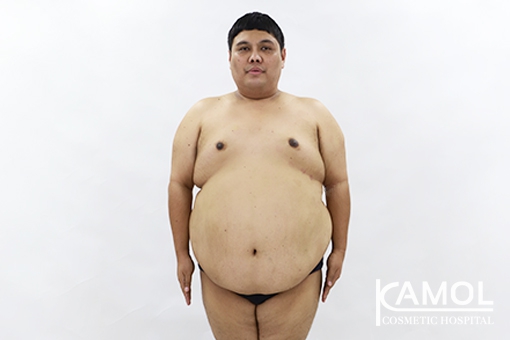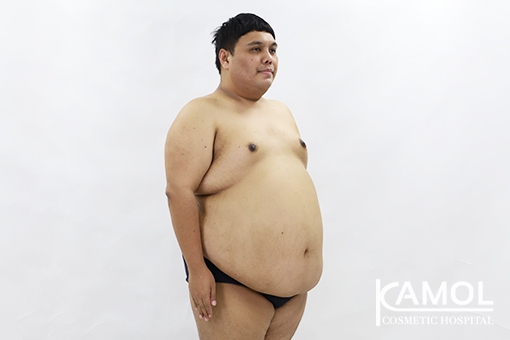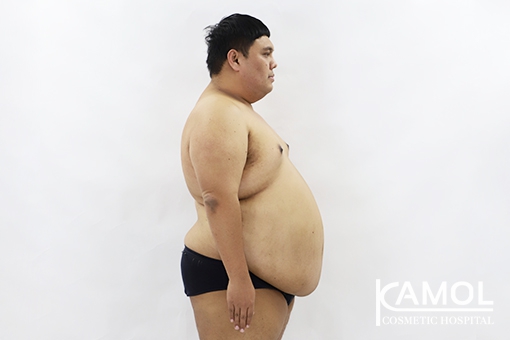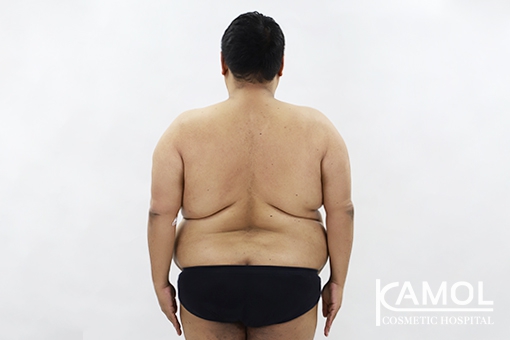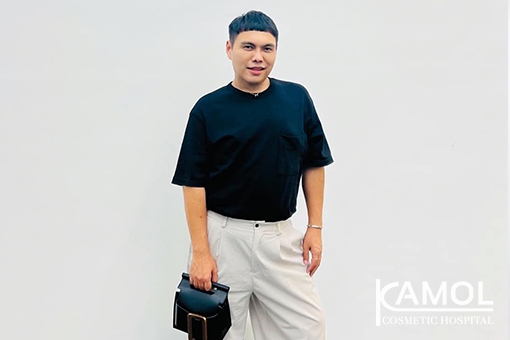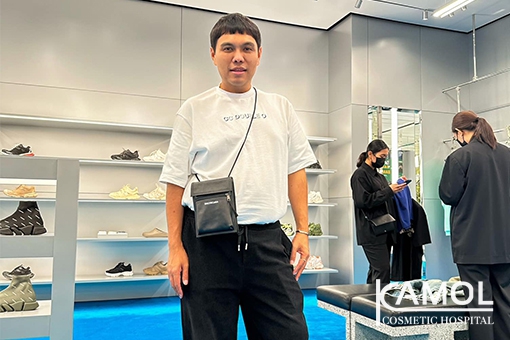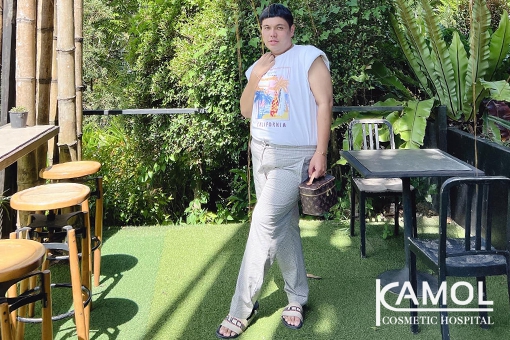Bariatric Surgery in Bangkok, Thailand
Modern lifestyle can be complicated, especially when it comes to eating right and living healthily. More and more we are faced with genetically modified food or fast food with inadequate nutrition and a busy, hectic lifestyle with not enough exercise. The problems that follow, among many health issues, are obesity such as diabetes, hypertension, coronary heart disease, and high cholesterol.
BMI or body mass index is an indication of obesity, calculated from weight and height in order to determine the balance between weight to height. BMI can be calculated by the body weight (kg) divided by the square of their height (m), the results can be interpreted as follows.
- Underweight: less than 18.5 (<18.5).
- Ideal: greater than or equal to 18.5 but less than 25 (≥18.5 but <25).
- Overweight: greater than or equal to 25 but less than 30 (≥25 but <30).
- Obese: greater than or equal to 30 but less than 40 (≥30 but <40).
- Risk: greater than or equal to 40 (≥40).
(https://en.wikipedia.org/wiki/Body_mass_index)
Guidelines to treat obesity:
1. Diet plans and exercise
2. Treatment with medication
3. Treat with medicine
4. Surgery
Diet plans and exercise
To safely and effectively treat obesity, healthy, low-carb and low-sugar diet should be incorporated in the patient’s lifestyle along with exercise sessions no less than 4 times a week. To achieve desirable result, each exercise session should also include at least 30 minutes of cardio workout, i.e. running, cycling or swimming, as it helps burn fat. If your BMI is higher than 30 and you have risk factors, please consult with your doctor.
Treatment with medication
For those with BMI of 30 or higher, treatment with medication can be administered with close supervision of a specialist doctor. This treatment plan is also suitable for those with 27 or higher BMI with risk factors involved.
Bariatric Surgery:
1. Gastric Sleeve (Sleeve Gastrectomy)
Procedure:
Today sleeve gastrectomy is the fastest-growing weight-loss surgery option in North America and Asia. In many cases, but not all, sleeve gastrectomy is as effective as gastric bypass surgery, including weight-independent benefits on glucose homeostasis. The precise mechanism(s) that produce these benefits is however not known.
(https://en.wikipedia.org/wiki/Gastric_bypass_surgery)
Advantages: This is the best way to lose weight. Diabetes, heart disease, high blood pressure and high blood cholesterol could also be cured with this procedure.
Disadvantages: Calcium, iron and vitamin deficiency might occur. There is a risk of bone erosion and anemia.
At Kamol Cosmetic Hospital, we use the minimal invasive surgery or laparoscopy which only causes small lesions on the abdomen.
Picture 1. Shows Vertical Sleeve Gastrectomy
http://www.nuffieldhealth.com/treatments/sleeve-gastrectomy
Preparing for Surgery:
A list of specialists to consult with before the surgery
1. Nutritionists
They can set up new diet plans and determine how much food should the patient consume after surgery, and how to lose weight before surgery.
2. Psychologists
Help manage and reduce stress before and after surgery.
3. Physicians specializing in obesity
Doctors of medicine closely monitor health conditions of the patient. They may offer counseling or medication for weight loss before the surgery.
4. Expert surgeons doing surgeries on obese patients
Surgery can be performed in specific cases. However, there are advantages and disadvantages to this surgery and the patient has rights to inquire before deciding to receive the surgery.
For consultation And practice with:
- The nutritional therapy to explain how much client should eat after surgery. And how to lose weight before surgery.
- Psychologists help in reducing the stress that may be more in the before - after surgery.
- Doctors of Medicine need to monitor health counseling therapy. Counseling or medication to lose some weight before the surgery.
- Medical-surgical alternative for patients that describes the procedures for each type has its advantages. The downside, however, the patient will be considered to have any right to them.
Complications:
- Bleeding
- Infections
- Outflow tract (tears in the bowels
- Follow-up or corrective surgeries
Postoperative complications may include blood clots from pulmonary disease, pneumonia or urinary tract infection, which are similar to any surgery. However, complications may occur less if the surgery is performed in a hospital or a medical center with team of expert doctors, especially anesthesiologists with expertise in handling obese patients. Post-surgery, proper equipment and care must be provided to monitor the patient, including teams of nurses and specially trained caregivers.
Why is weight loss surgery good?
With less weight and obesity, a person has lower health risks that include diabetes, hypertension, heart disease, cancer, sleep apnea among many others. Also, people with less obesity requires less expenses to care for their health
What happens after the surgery?
- Patients must be admitted in a hospital for three days to make sure that there are no complications and can function without taking analgesic.
- Exercise as soon as they feel better with exercise program designed specifically for them.
- Adopt new diet plan designed by nutritionist for at least one month.
2. Gastric Balloon
The gastric balloon is an effective solution to severe obesity. It is recommended for patients that need to lose weight before having a weight-loss operation to reduce their surgical risk.
A deflated balloon is placed through the mouth and esophagus, then filled with liquid, which is designed to partially fill your stomach, giving you a feeling of fullness. This will help you change your eating pattern, reduce the volume of food eaten and making you feel full quicker. The balloon is designed to stay in place for a maximum of six months, after which it must be removed in a similar way it was inserted.
How is the balloon inserted?
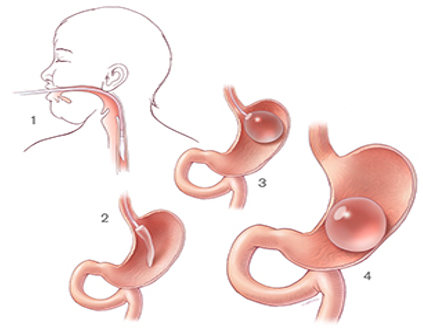
Picture 2. Shows Gastric Balloon procedures
(Ref: www.loyolamedicine.org/weight-loss-bariatrics/gastric-balloon)
In the treatment room, your throat will be sprayed with a numbing spray. It tastes unpleasant but it is very effective and within a few seconds, your throat will feel numb. Although this is quite a strange feeling, it is harmless and will help you tolerate the gastroscopy tube (camera). If you have false teeth, you will need to remove them. You may also be able to have an injection to make you feel sleepy if you wish, but this will be discussed with you.
Once the nurse has made you comfortable on the trolley, a plastic mouth guard will be put between your teeth and gums to keep your mouth slightly open. Throughout the procedure your pulse, blood pressure, breathing, and oxygen levels will be monitored, and a small sponge may be placed into one nostril to provide you with a little oxygen. This is completely routine and there is nothing to worry about.
An endoscope will then be passed through your mouth and down into your stomach. This will not cause you any pain and will not interfere with your breathing. In order to have a clear view of your stomach, it may be necessary to put some air down the endoscope. This may give you the feeling of wanting to belch. Once the endoscope has been removed, the surgeon will pass the deflated balloon through your mouth and down into your stomach. The endoscope will be reintroduced to check that the balloon is in the right position before it is inflated with liquid.
Pre-procedure diet
Before insertion of the gastric balloon, you must fast from food and drinks for 12 hours. When the gastric balloon is to be removed, you must start on a fluid-only diet 48 hours beforehand. This means no solid food at all. At this point, it may be useful to have some fizzy drinks, as they can help cleanse the balloon, making it easier to remove. 12 hours before the balloon is due to be removed, you must fast. This means no food or drinks.
What diet will I follow once I have had the balloon inserted?
For the first week, you will need to follow a fluid-only diet. This allows the stomach to get used to the balloon. You need to drink plenty of fluid to prevent dehydration.
The key points are:
• Drink slowly, sip at drinks
• Do not drink more than 100ml at once
• Drink about 2 liters (8 cups) a day.
The best fluids are low fat or low sugar varieties. These include semi-skimmed or skimmed milk, low fat yoghurt drinks, soup with no lumps. You must avoid coffee and fizzy drinks.
Over the following week, you will progress onto a pureed diet, followed by a soft, mushy diet, building up finally to a normal diet. You will see the dietitian one week after the balloon insertion to discuss the stages. Also, at this appointment, your long-term plan will be discussed.
If you suffer from diabetes, you may need to monitor and record your blood sugar levels very closely, as a change in your medication may be required.
What are the benefits of having a gastric balloon?
Having a gastric balloon helps you to achieve short-term weight loss. It also helps to reduce health-related problems such as:
• Diabetes
• High blood pressure
• Heart disease
• Joint pain
• High cholesterol
What are the risks and complications?
Most people have few problems during and after the procedure. However, sometimes there may be complications or difficulties such as:
• Bleeding or perforation as a result of injury during insertion or removal of the balloon, requiring surgical correction.
• Low levels of oxygen in the blood, or irregular heartbeat (occasionally, this is serious enough to cause a heart attack). So that we can watch out for these problems, your oxygen level and pulse will be monitored throughout the procedure.
• There is a slight risk to crowned teeth or bridgework. The risk can be reduced by telling us if you have either of these.
• Bowel blockage by the balloon, when a partially deflated balloon passes into the small bowel. This is extremely rare but if this occurs it needs removing during an operation or by an endoscopic procedure.
• A blue dye is added to the saline that is injected into the balloon, so that in the rare event that the balloon were to leak, you would know immediately by the change in color of your urine. If this were to happen, you should contact the hospital immediately so the balloon can be safely removed.
• Stomach discomfort, nausea and vomiting are common for the first week following the balloon placement but this rarely continues after this time.
• Feeling of heaviness in the abdomen, or abdominal or back pain
• Acid reflux and indigestion (you will be prescribed medication to reduce your stomach acid production while the balloon is in place)
• Very rarely, patients develop a chest infection after the procedure. If you develop a cough, you should contact your doctor.
The chance of these risks occurring is small, but it is important that you are aware of them and that you have all the information you need before agreeing to the procedure.
What happens before the procedure?
If the gastric balloon procedure is a safe and suitable option for you, you will be asked to attend the hospital for a pre-procedure assessment. At this appointment, we will ask you questions about your medical history, medication, and any other operations you may have had in the past. You may need to undergo some routine tests, for example, a heart trace (ECG), x-ray, and blood tests.
What happens on admission to the hospital?
You will come to the hospital the morning of your procedure unless told otherwise. On admission, the doctors and nurses will answer any further questions you may have. A nurse will check that there have been no significant changes in your health since your pre-assessment, and your temperature, pulse, blood pressure and breathing will all be recorded. Before having your procedure, you will be asked to put on a gown. You will also be asked to wear compression stockings (anti-embolic). They help blood flow in the deep veins in the legs and so reduce the risk of developing blood clots. You will need to wear these for approximately six weeks after your procedure. You will be asked to walk to the procedure room.
Will I be put to sleep?
A numbing throat spray will be used before the procedure. Alternatively, you may be given medication into a tube in your arm or hand, which will make you feel very sleepy. You should still be able to hear what is being said and co-operate with verbal instructions, but later you may have little or no recall of the procedure.
What can I expect after the procedure?
From the procedure room, you will be transferred to the ward. The nursing staff will check your pulse, blood pressure, temperature, and breathing. You may have a sore throat as a result of the endoscopic equipment. If you have had some sedation, you may feel sleepy for a while and you may be given oxygen through two little prongs in your nose until you are fully awake. You will be encouraged to get up and move around soon after your procedure. This is to reduce the risk of developing a blood clot.
Will I feel sick?
Many people feel sick and do vomit after the procedure and for some time afterwards. You will be prescribed anti-sickness medication, which are drugs to help relieve the nausea and vomiting. The sickness should settle once your stomach has become used to the presence of the balloon.
Will I be in pain?
You may have a feeling of heaviness in your abdomen and pain in your abdomen and back. You will be prescribed painkillers to help relieve this.
When will I be able to go home?
You will usually be able to go home on the day of, or the day after, your procedure, depending on how you feel. You must have someone responsible to take you home because you may still be feeling the effects of sedation. We would also advise that someone stays with you for 24 hours.
What will follow-up care be?
You will be sent an appointment to see the dietitian and the nurse specialist in the outpatients’ department approximately one week after going home. You will also be given the phone numbers of the specialist nurse and dietitian to contact for any advice you may need at other times. When your balloon is ready to be removed, six months after insertion, the hospital will make arrangements for its removal and send you an appointment.
- Ref: Doncaster and Bassetlaw Hospitals NHS Foundation Trust. (2012). Gastric Balloon procedures. Bariatric surgery
Getting to Know for Bariatric Surgery:
Sleeve gastrectomy diet
Sleeve gastrectomy is a type of weight loss surgery that involves reducing the size of the stomach,...
Sleeve gastrectomy vs Gastric bypass
Obesity is a growing problem worldwide and bariatric surgery has become an increasingly popular...
What are the side effect of sleeve gastrectomy?
It is important to understand that like any other surgery, it is associated with certain risks and complications.
See more
Reviews Sleeve Gastrectomy
Why is sleeve gastrectomy considered for weight loss?
Sleeve gastrectomy, also known as a vertical sleeve gastrectomy, is a weight loss surgery that involves removing a large portion of the stomach, leaving a smaller "sleeve" shaped stomach. This smaller stomach can hold less food and as a result, patients feel full more quickly and eat less. The procedure is typically performed laparoscopically, which is less invasive than open surgery and has a faster recovery time.
One of the key benefits of sleeve gastrectomy is that it can lead to significant weight loss. On average, patients can expect to lose 50-70% of their excess weight within the first year after surgery. The weight loss also tends to be more stable and long-lasting compared to other weight loss options such as diet and exercise.
Sleeve gastrectomy also leads to hormonal changes that promote weight loss. Ghrelin, which is known as the "hunger hormone," is produced in the stomach. Ghrelin levels decrease after sleeve gastrectomy, leading to a reduction in hunger and cravings.
While sleeve gastrectomy is considered to be less invasive and has a lower risk of complications compared to other weight loss surgeries such as gastric bypass, it is still a major surgery and should be approached with caution. As with any surgery, there are risks such as bleeding, infection, and blood clots.
It is important to note that weight loss surgery should be considered as a last resort after all other options have been exhausted. Patients should also be under the close supervision of a medical professional and have a comprehensive evaluation before undergoing surgery to ensure they are appropriate candidates. Additionally, patients will need to make significant lifestyle changes including regular exercise, healthy eating, and follow-up with their medical team to ensure the best outcome





